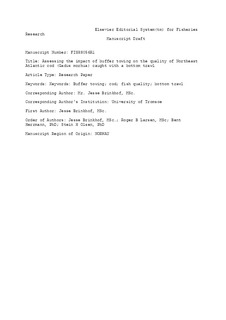| dc.description.abstract | The dense aggregations of Northeast Atlantic cod (Gadus morhua) in the Barents Sea have led to a new fishing practice termed “buffer towing.” In this fishery, many trawlers redeploy the trawl directly after taking the catch onboard in an attempt to secure a continuous supply of fish and avoid any unnecessary stops during processing. If the approximate desired amount of fish is caught or exceeded before the catch from the previous haul is processed, the trawl is lifted off the seabed and towed at a given depth at low speed, usually ∼1–2 knots, until the production capacity of the onboard factory is restored. Both researchers and fishermen onboard trawlers believe that buffer towing has a negative impact on fish quality, as indicated by increased frequency of gear marks and dead fish, poorer exsanguination, ecchymosis, skin abrasion, fillet gaping, and fillet redness. However, the effect that buffer towing has on fish quality has not been scientifically evaluated. The aim of this study was to document the effects of buffer towing on fish quality. The quality was assessed using two different indexes, one for whole cod and one for cod fillets. The results proved that buffer towing has a negative impact on fish quality. Specifically, cod subjected to buffer towing, in contrast to direct haul-back, had an increased relative probability of 371% for poor exsanguination and an increased relative probability of 209% for fillet redness. Furthermore, combining scores of the different quality categories within the indexes (e.g., gear marks, ecchymosis, poor exsanguination, and skin abrasion) proved a significant reduction in the quality of cod subjected to buffer towing. | nb_NO |

